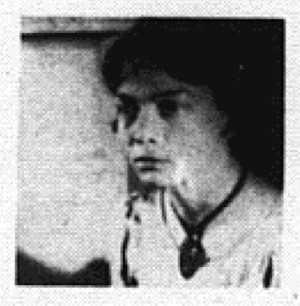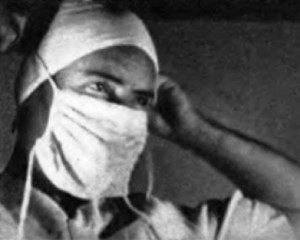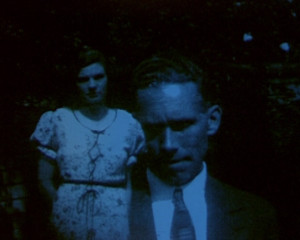
"Film is a fictional story about a teenaged woman named Vanessa who returns to her Yorkville home to find that her parents are at a cocktail party and her sister is being babysat by someone who isn't what 'she' seems" Archives of Ontario.
"Okamoto again demonstrates his fine sense of composition, repose and rhythm. Okamoto never hurries his pictures, neither does he hold them too long to bore you. He plans only to give you another fine picture, but he always puts life into his shots. Autumn Leaves is a fine Okamoto offering, but in the opinion of the judges it does not contain the same spark of creation as his last year's effort, 'Tender Friendship'." American Cinematographer, Jan. 1936, 24.
"In the countryside of Japan, the atmosphere of autumn is captured in shots of bare trees, reeds, reflections and sunlight on rippling water, floating leaves and dark clouds. A woman carrying a small child on her back is reflected in water as she stands near a pole, then rests against a harvest stack while crocheting from a ball of yarn. She walks along a path surrounded by farmed terraces. A child (described in the opening titles as motherless) plays with a paper ball while the grandfather tills the soil. The child blows into the ball to inflate it and the grandfather gets out his pipe and lights it with a match. Then he helps to inflate the ball. Against a sky of darkening clouds, they walk along the path, the man carrying the rake and the child a kettle. A woman with an infant on her back passes them, and the child stops and watches after her as she moves away. Then the child stops at a wayside shrine, and the grandfather offers comfort. Against low sun beneath dark clouds they are seen in silhouette as they continue on their way" (EAFA Database).

"It is a late fall day, blustery and bleak, just before the first snow. The visit by the Angel of Death is heralded by the blowing leaves and the lonesome cry of the starlings. Dramatic camera work and original music scoring create the suspense and drama of this story in a setting of an old New England state in the early 1900s. This highly imaginative film by John Riley was awarded the MPD Student film Award" PSA Journal, Oct. 1963, 41.
"The Wayward Mink. It is hard to believe, but the plot in this film is exactly the same as in The Boomerang, made by filmers in Montreal. Were it a simple, everyday plot, the coincidence would not be so remarkable, but these two filming groups are over 3000 miles apart. In the Mink as in the Boomerang, a wayward wife accepts a gift from her lover, only this time it is a mink stole instead of Boomerang's necklace. Again, the wife wonders how she can get her husband to "find" it and, she hopes, present it to her. And, to top it all off, what eventually happens to the wayward mink also happens to the necklace. Though the plots are identical, the treatments are entirely different" PSA Journal, Sept. 1966, 36.
"Myron F. Pettengill was awarded the trophy for Scenario pictures. This is a 16mm film of about 400 ft. It is a story of the Northwest Mounted. Pettingill is to be commended for his direction, his types, and the way in which he costumed his people. He injected little touches in his characters that left no doubt as to what they represented. He costumed them convincingly. It had many indoor scenes and of course a large amount of outdoor snow scenes. There was a fine handling of the camera." American Cinematographer, Jan. 1937, 25.

"The Will and the Way is a simple story of '"little people" — but it looms large in its appeal to the human heart. There are, in its tender adventures, the laughter of sympathy and the tears of pathos. From these, as from any great expression of beauty, there comes the genuine and ennobling uplift of the spirit which is so rare in a workaday world. Chester Glassley has been equal to his task. His photography, both indoors and out, is as nearly flawless as skill and patience will permit. His camera treatment is marked by a wise concentration on close views, a dramatic selection of angles and a fine sense of matching and contrasting color values. Good cutting, paired with a brilliantly executed montage sequence, rounds out the technical achievements. But his greatest production triumph lies in the casting and direction of the two lead players, who bring to the amateur screen its most genuine and sensitive acting to date. A young wife is to have a baby. Because of a harsh experience with a rum sodden doctor, she turns blindly toward the thought of going only to a specialist, a great obstetrician, famed both for his fine care and his $1000 fees. Her young husband's reaction as he learns of this feeling is the simple theme of the entire story: "I don't know where we'll get the money, but if that's the doctor you want, then that's the doctor you're going to get!" From then on. life for the young couple is a race against time, punctuated for the husband by a frantic search for cash, which leads him through the indignities of a pie eating contest, the insults of '"amateur night" and the bruises and battering of a vastly unequal prize fight. But the baby wins in the end. The harried father collects only three hundred dollars of the specialist's fee, a sum he begs the great doctor to accept as a down payment. This the physician does, only to return the entire amount later — with a receipted bill — as his tribute to the boy's courage. The Will and the Way is a short, unassuming film, made technically with the simplest tools provided by the craft. But, in its unfailing imagination, its moving tenderness and. above all. in its deep understanding of the human heart, this film is a proud peer among its colleagues of the Hiram Percy Maxim Award." Movie Makers, Dec. 1940, 576-577.
"With Stronger Reason is a photoplay about an artist who is disgusted with his efforts–disgusted, in fact, with life in general–at least what life has been to him. Flashbacks at the beginning work to the film's favor, and excellent black-and-white photography plus some of the best camera work in this contest in recent years are features of this outstanding story film. It also received the MPD Scenario Award and the MPD Sound Award" PSA Journal, Sept. 1964, 50.
"Wonderland Trails is a triumph of treatment over the subject matter. K. G. Stephens, ACL, has used with sensitive artistry the space and time saving devices of closeup synecdoche, lap dissolve and the fade in, telling his charming tale of a mountain hike that went astray. On this simple framework he has presented a series of lovely scenic views, always well photographed and often superior in their crisp beauty. Smart editing serves throughout to reinforce the values of this film, which is distinguished by an imaginative and careful advance planning." Movie Makers, Dec. 1933, 523.

"Beneath ominous storm clouds, the recently engaged Ann Lister (Winifred Poyser) and Bob Randle (Harry Ellis) argue about their ideas of marital bliss - she wants a house in town, he prefers a country cottage. As the argument reaches its peak, Ann removes her engagement ring, and hands it back to Bob, who walks away, crestfallen. Visiting Amelia - "a very modern girl with very modern ideas about love" - Ann admits that she broke off the engagement in an attempt to find out if Bob really loves her. Following a series of encounters in the street, Ann hatches a plan to become the leading lady opposite Bob in a new theatrical production. But will their love survive the ultimate test?" (EAFA Database)
Total Pages: 12